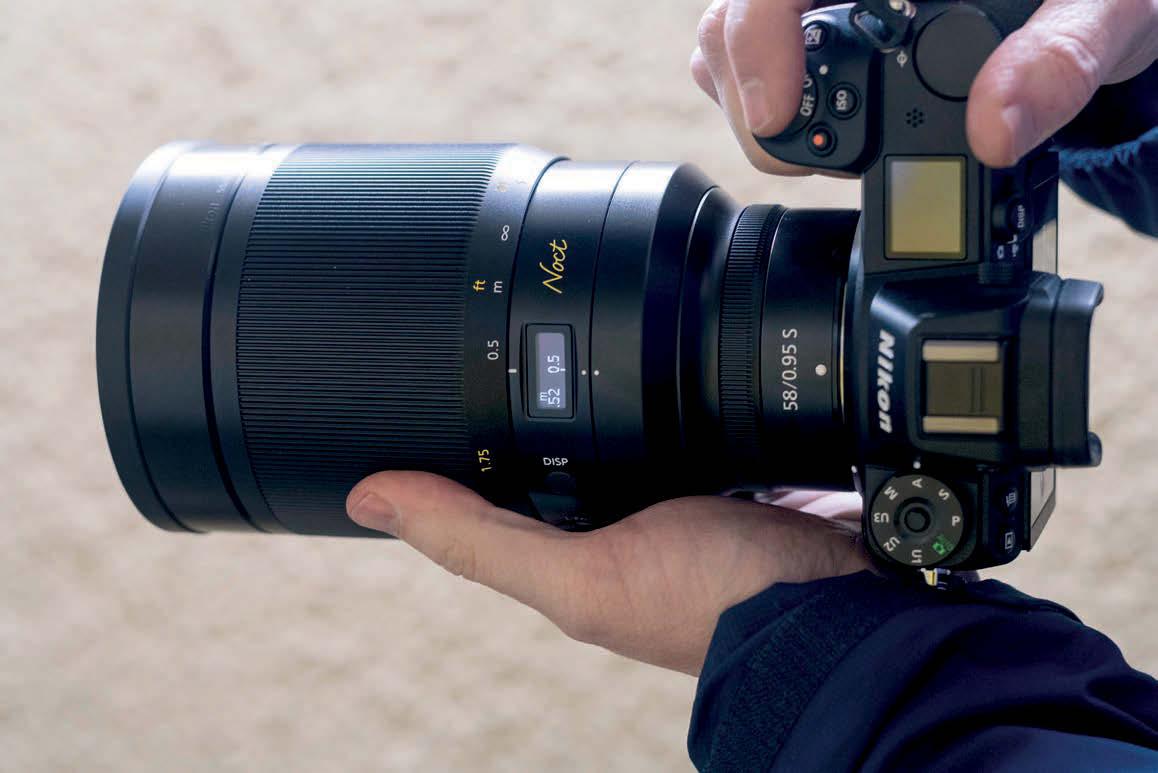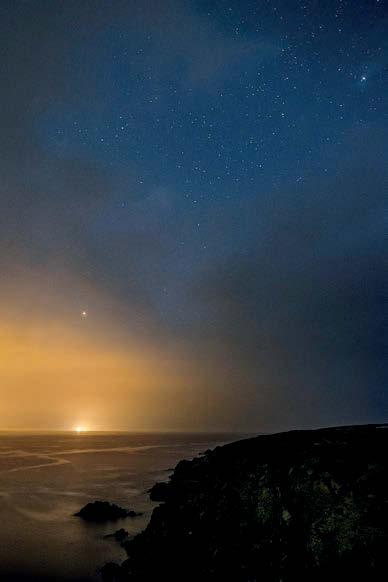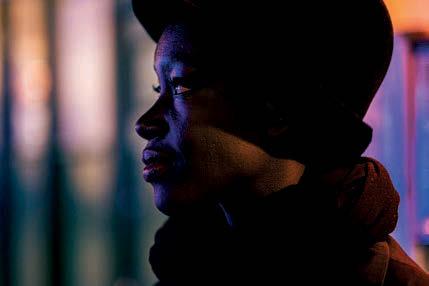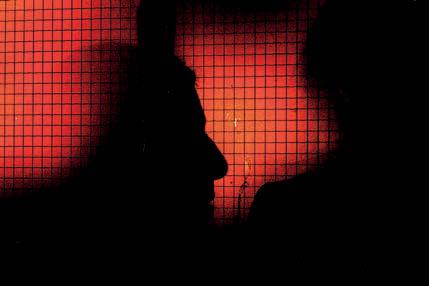
10 minute read
Fast workers
Nikon’s Z 58mm f/0.95 might seem extravagant, but the widest apertures can work wonders
With more and more very wide aperture lenses available, how do they help with low-light shooting – and what are the considerations? We spoke to three photographers working across portrait, landscape and street
The advantage of fast lenses comes from their very wide maximum apertures. Pound for pound, more light means faster exposures at lower ISOs, which are useful across the board, and the secondary effect of aperture – depth of field – gives photographers creative choices. More light also makes AF more efficient. These benefits can be felt in almost any sphere of photography and across the next few pages we’ll hear from how they help photographers who are working in very different subjects.
But before we get started, it is important to understand just what fast lenses are. This is a slippery term and whether a lens’s maximum aperture defines it as ‘fast’ depends on several factors. It’s also highly relative.
For starters, there’s focal length. A 50mm f/1.8 lens might not be seen as particularly fast by modern standards, but a 135mm f/1.8 lens would be, particularly as that’s about the fastest you can practically go at that focal length. Similarly, a 14-24mm f/2.8 is considered fast for a full-frame zoom, but a prime lens at any of its focal lengths wouldn’t be.
What’s more, just as with focal length, what’s considered ‘fast’ is relative to sensor size. On smaller-sensor systems, like APS-C and Micro Four Thirds, you’ll find options stating wider maximum apertures than full frame, but when equated to a bigger sensor the effective aperture falls.
Of course, despite all their benefits, fast lenses have drawbacks, too. Comparatively, they’re larger and heavier than ‘slower’ lenses, so not right for all occasions. The very fastest lenses usually don’t feature AF, and you might find that sharpness isn’t at its peak when shooting wide open, where you’ll also see more vignetting. They’re also more expensive, so you need to choose wisely when it comes to investing. Let’s find out more.
Not only do fast apertures deliver subject separation, they can also let you freeze movement more easily Sony Alpha 9 II, 135mm f/1.8 lens, 1/400sec at f/2, ISO 125
Kate Kirkman

Kate is an experienced pro photographer, specialising in weddings, portraits and boudoir subjects, with a style emphasising fine-art storytelling. She’s a Sony Europe Imaging Ambassador, and also offers photo training at trainingbylumiere.co.uk.
Portraiture
PORTRAIT photographers love fast lenses – especially for low-light projects. I shoot with Sony Alpha cameras and my go-to fast lenses are the 50mm f/1.2 GM and the 135mm f/1.8 GM. My indoor workhorse used to be the 24-70mm f/2.8 GM, but those two primes have now replaced it for interiors.
Why? It’s about a lot more than shallow focus. Beginner photographers can obsess over fast lenses and most of that is about getting wafer-thin depth of field. But as you grow and work more, it’s normal for that to become secondary to the real meaning of ‘fast’ lenses – the advantages they give in exposure speed.
Often my work means operating in low light. Sometimes that’s forced on me, but more usually it’s illumination I find in locations or create myself for a more atmospheric or flattering look, and it’s part of my style. But my preferences aren’t going to convince a camera to do anything other than read the light and expose as best it can!
I need a fast lens to help me keep image quality at the maximum in terms of ISO and also to keep shutter speed up, both to avoid camera shake – yes, despite my Alpha’s amazing IBIS it can still happen – and to freeze subject movement. Comparing my 24-70mm f/2.8 to my 50mm f/1.2, I’ve got over two stops more light, so I can shoot faster and/or use lower ISOs. Beginners tend to only see shallow depth of field and think it’s great for a while. But it’s not enough. The key is always to find the right light and a lens’s worth is in helping you work with that.
There’s also lots to take into account when shooting at the widest settings. It’s certainly not a free pass. Before I moved to Alpha mirrorless cameras I would not always be confident in shooting at f/1.4 or below. Depending on how close you are to the subject, depth of field can be microscopic and for professionals focus has to be spot on. It’s only with eye-detection AF that I feel really comfortable.
Even then – and though I have f/1.2 or f/1.8 available – I often don’t shoot right at the maximum. As good as modern lenses are, they usually hit a sweet spot of sharpness just below wide open, and what’s more, I don’t always want the shallowest depth of field. That’s particularly true when shooting couples or groups.
I want the option to shoot at very wide apertures, even if I don’t always do it. Fast lenses are more expensive, but choose wisely and they’re a brilliant investment. When shooting portraits using low-level available light, fast lenses are a must Sony Alpha 1, 50mm f/1.2 lens, 1/200sec at f/2, ISO 500

Planes of focus
It’s important to learn how your fast lenses render depth of field, both on their focal length and distance to the subject. Get comfortable with this – even using depth-offield calculator apps in the beginning – or you could find subjects are blurred by mistake.
The widest apertures allow more textured seas in low-light situations, showing the energy of the waves Nikon D850, 28mm f/1.4 lens, 1/4sec at f/2.2, ISO 640

Kingsley Singleton
Kingsley is a photographer, tutor, and writer with decades of experience in shooting technique and image editing. Specialising in landscapes, nature and travel, he lives in Lincolnshire but likes to travel to hillier places. Follow his work at @kingsley.photo
Landscapes
MANY photographers think scenics are a subject where you don’t need particularly fast lenses. Typically people are shooting in daylight or twilight, and using tripods. And with most landscapers wanting the whole scene in focus, the aesthetic benefits of very fast lenses can be seen as limited, too.
But there are lots of situations where fast apertures are vital. And at those times – while I often use 14-24mm, 24-70mm and 70-200mm f/2.8 zooms for my landscape work – I also rely on fast prime lenses, in particular 20mm and 28mm f/1.4s. The combination of wide aperture and broad field of view makes them perfect for lots of subjects.
Maybe the most obvious is when shooting landscapes with starry skies. Though I have a star-tracker – which compensates for the rotation of the Earth and allows long exposures without creating ‘star trails’ – there are times when it’s impractical to use, or I just want to travel lighter. In those situations, fast, wideangle lenses are vital.
Shooting at the maximum or just below it, the extra light gives good exposures at lower ISOs but more importantly allows shutter speeds that don’t show trailing, for instance, staying under 18secs on a 28mm, or under 25secs on a 20mm. On slower lenses I’d need to bump up the ISO to get similar speeds which isn’t always welcome when already operating at high levels in the dark.
Exposure time also comes into play with Earthly subjects. At the coast, I may want the sea to show its texture and violence. In low light, that’s tough, and available shutter speeds might calm waves into a misty blur, which isn’t my intention. A fast lens will let me work in fractions of a second rather than tens of them.
Despite the front-to-back sharpness aesthetic than many landscape images feature, shallow depth of field can be remarkably effective, too. I will often change up from deep to shallow focus to give scenes a different feel. Just as though shooting a portrait, it’s also useful when making the best of subjects that have distractions around them, or for framing through foreground elements such as leaves or long grasses.
Of course, extra care needs to be taken with focus, but also remember that the characteristics of a lens change throughout its aperture scale. Wide open or close to it, you can see more flare, while lights and sun will diffuse, the opposite to small apertures which turn them into starbursts. If you want to avoid star trails in night landscapes, apertures from f/1.4 to f/2 make it easier Fujifilm X-Pro 2, 16mm f/1.4 lens, 20 seconds at f/1.6, ISO 3200

Manual focus
Whether it’s astro or other low-light subjects, when shooting landscapes at apertures like f/1.4 I always focus manually. It’s more effective than AF in low-light scenes and I’ll always zoom in to check critical sharpness for each frame because it’s easy to knock focus when setting up.
Street portraits at night need fast apertures to avoid subject movement Fujifilm X-Pro 2, 56mm f/1.2 lens, 1/320sec at f/1.2, ISO 3200

Brian Lloyd Duckett

Fujifilm Ambassador Brian lectures widely on street photography and has written two best-selling books – you’ll also find him on YouTube. Brian runs around 70 street photography workshops every year, so find out more at streetsnappers.com
Street
THERE ARE plenty of times when opening up with a fast lens can bring real benefits to your street photography.
It’s currently very popular to shoot wide open – particularly when working at night when we want to create some mood and atmosphere. Early practitioners like Winogrand and Meyerowitz were pretty much committed to shooting at f/8 or smaller – but there’s a new kid on the block, who is much more concerned with ‘look and feel’ than he is with ‘content’. And, more often than not, this new aesthetic is created using a wide aperture.
Saul Leiter, undoubtedly one of the greatest street photographers ever, was the first to break with tradition, using lenses that were both longer and faster than those used by his peers, producing layered work which often had an out-of-focus foreground. He certainly started something!
My ‘holy trinity’ of prime lenses for street are the Fujifilm 23mm f/1.4, 35mm f/1.4 and 56mm f/1.2 – these are 35mm, 50mm and 85mm full-frame equivalents, respectively. I rarely use anything else and whilst much of my work is shot at f/8 or f/11, it’s good to have the ability to open wide when the right opportunity arises.
You’ll often find me shooting street at night, when a fast maximum aperture is essential. The wider the aperture, the better – f/2 is okay, f/1.4 is perfect and anything faster than that is a real bonus. Some street shooters are even buying the new breed of inexpensive f/0.95 manual focus lenses which can produce stunning and very ‘characterful’ results.
At night I set my lens at its widest setting and rarely deviate from that. This means that I need to take more care focusing, but with so much light entering the camera I can keep a lid on the ISO setting.
Night shooting aside, I sometimes shoot wide open as a deliberate aesthetic consideration and I find myself using this approach more than ever before to declutter a scene or to make the subject more prominent.
Then, of course, there are street portraits where a fast aperture is often vital in softening awkward or distracting backdrops, or simply to place emphasis on the eyes. My preferred style for portraits is to have a very soft background; step in, again, the fast lens.
Essentially, having lenses that give me the option to go as wide as f/1.4 or beyond gives me shooting possibilities that other models lack, and that’s something I wouldn’t want to be without. Cluttered backgrounds are less of a problem when shooting wide Fujifilm X-E4, 56mm f/1.2 lens, 1/30sec at f/1.2, ISO 400

Manual focus can be surprisingly helpful at the widest settings Fujifilm X-T30, 56mm f/1.2 lens, 1/480sec at f/1.2, ISO 4000
Keep it sharp when open
When working wide open, focus needs to be precise. When I use AF, it’s in the standard single-shot (AF-S) mode, never continuous, and I don’t really trust face detection, preferring to keep full control. Otherwise I focus manually, even at the widest apertures, and rely on aids like a magnified view or focus peaking to help.










